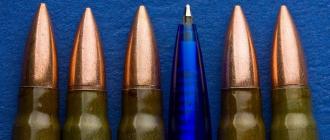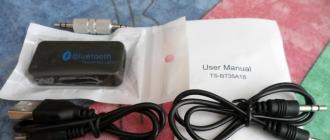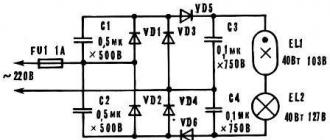Stereo amplifier on TDA2003 + JRC4558.
We present to your attention a schematic diagram of a full stereo amplifier built on TDA2003 microcircuits. According to the datasheet, TDA2003 will give 6 watts of power to a load of 4 ohms. The power supply of the amplifier is unipolar 12 volts, so it can be used as a car audio system. If you are interested in the amplifier parameters in more detail, you will find a complete description (datasheet) in the archive with the materials of this article. This amplifier also contains a pre-amp and three tone controls, which are implemented on the JRC4558 MC. The schematic diagrams are shown below:
Power amplifier circuit on TDA2003:
JRC4558 pre-amplifier circuit with three-band tone control:

In the pre-amplifier, the JRC4558 chip can be replaced, for example, with the TL072.
All elements of the amplifier, together with the regulators, are placed on one board. The PCB sources are shown below:


Using these images we drew a printed circuit board in Sprint Layout, below is a view of a LAY6 amplifier board:
The photo view of LAY6 format is as follows:
One-sided foil glass fiber laminate, size 71 x 126 mm.
TDA2003 microcircuits are installed on one common radiator, so don't forget about thermal grease and insulating gaskets with insulating bushings.
The convenience of the board lies in the fact that regulators are installed directly on it, therefore, the use of wires for external connections is significantly reduced. All variable resistors are paired 2 x 20 kOhm with a linear characteristic, that is, if imported, then with the "B" index, if domestic - with the "A" index.
The amplifier board assembly is shown below:


When power is applied to the amplifier, the red LED next to the input jack lights up. In its circuit there is a 2.2 kΩ current-limiting resistor.
After the elements have been soldered, rinse the board thoroughly, for example, with solvent 646, remove excess rosin and make sure there are no “snot” (tin jumpers between the tracks). Check again if the elements are correctly soldered (4558 microcircuit, electrolyte polarity, etc.)
An amplifier assembled without errors and of serviceable parts does not need additional settings. Happy repetition.
List of amplifier elements with preamp and tone control:
Microcircuits:
● TDA2003 - 2 pcs.
● JRC4558 - 1 pc.
1 / 4W resistors:
● 47R - 2 pcs.
● 2R2 - 2 pcs.
● 220R - 2 pcs.
● 1R / 0.5W - 2 pcs.
● 1K - 4 pcs.
● 10K - 2 pcs.
● 2k7 - 4 pcs.
● 100K - 2 pcs.
● 220K - 2 pcs.
● 2k2 - 1 pc.
Capacitors for a voltage of at least 16V:
● 1000mF electrolyte - 2 pcs.
● 470mF electrolyte - 2 pcs.
● 100mF electrolyte - 2 pcs.
● 1mF electrolyte - 6 pcs.
● 10mF electrolyte - 1 pc.
● 0.047mF (473) film - 2 pcs.
● 0.1mF (104) film - 4 pcs.
● 0.1mF (104) ceramics - 1 pc.
● 0.0047mF (472) film - 2 pcs.
● 470pF (471) ceramics - 4 pcs.
Rest:
● Paired variable resistor 20k + 20k - 4 pcs.
● Connector with bolt clamp 2 Pin 5 mm for board mounting - 3 pcs.
● Connector with bolt clamp 3 Pin 2.54 mm for board mounting - 1 pc.
● LED - 5 mm red LED - 1 pc.
● Socket 8 Pin for JRC4558 - 1 pc.
● Aluminum radiator for TDA2003 - 1 pc.
● Dual RCA connector - 1 pc.
● Terminal for connecting acoustics - 1 pc.
You can download the amplifier circuit for TDA2003 & JRC4558, printed circuit board LAY6 format and datasheet_TDA2003 using a direct link from our website, which will appear after clicking on any line of the ad unit below, except for the line “Paid advertising”. File size - 0.93 Mb.
Microphone preamplifier, he is also a pre-amplifier or amplifier for a microphone - this is a type of amplifier, the purpose of which is to amplify a weak signal to a linear level (about 0.5-1.5 volts), that is, to an acceptable value at which conventional sound power amplifiers work ...
The input source of acoustic signals for the pre-amplifier is usually vinyl record pickups, microphones, pickups of various musical instruments. Below are three schemes of microphone amplifiers on transistors, as well as a variant of a microphone amplifier on a 4558 microcircuit. All of them can be easily assembled by hand.
Simple single-transistor microphone preamplifier circuit
This mic preamp circuit works with both dynamic and electret microphones.
Dynamic microphones are similar in design to loudspeakers. The acoustic wave acts on the membrane and on the acoustic coil attached to it. At the moment the membrane oscillates, an electric current is generated in the coil, which is under the influence of the magnetic field of a permanent magnet.
The operation of electret microphones is based on the ability of certain types of materials with an increased dielectric constant (electrets) to change the surface charge under the influence of an acoustic wave. This type of microphone differs from the dynamic one by its high input impedance.
When using an electret microphone, to bias the voltage across the microphone, set resistance R1
single transistor microphone amplifier
Since this microphone amplifier circuit is for a dynamic microphone, when using an electrodynamic microphone, its impedance should be in the range from 200 to 600 ohms. In this case, C1 must be set to 10 microfarads. If it is an electrolytic capacitor, then its positive terminal must be connected towards the transistor.
Power is supplied from the crown battery or from a stabilized power source. Better on battery power, though, to eliminate noise. can be replaced with a domestic one. Electrolytic capacitors for a voltage of 16 volts. To prevent interference, it is necessary to connect the preamplifier to the signal source and to the amplifier input with a shielded wire. If you need further powerful sound amplification, then you can assemble an amplifier on a microcircuit.
Microphone preamplifier with 2 transistors
The structure of any preamplifier has a very strong effect on its noise performance. If we take into account the fact that high-quality radio components used in the preamplifier circuit still lead to distortions (noise) to one degree or another, then it is obvious that the only way to get a more or less high-quality microphone amplifier is to reduce the number of radio components in the circuit. An example is the following scheme of a two-stage preliminary.

With this option, the number of blocking capacitors is minimized, since the transistors are connected in a common emitter circuit. There is also a direct connection between the cascades. To stabilize the operating mode of the circuit, when the external temperature and supply voltage change, DC feedback is added to the circuit.
Three-transistor electret microphone preamplifier
This is another option. The peculiarity of this amplifier circuit for a microphone is that the power supply to the preamplifier circuit is carried out through the same conductor (phantom power) through which the input signal goes.

This microphone preamplifier is designed to work together with, for example, MKE-3. The power supply to the microphone goes through resistance R1. The audio signal from the microphone output is fed to the VT1 base through the C1 capacitor. , consisting of resistances R2, R3, the necessary bias is created based on VT1 (approximately 0.6 V). The amplified signal from the resistor R5, which acts as a load, goes to the base of VT2, which is part of the emitter follower to VT2 and VT3.
Two additional elements are installed near the connector at the output: a load resistance R6, through which power is supplied, and a blocking capacitor C3, which separates the output audio signal from the supply voltage.
Microphone pre-amplifier on a 4558 chip
The 4558 operational amplifier is available from ROHM. It is characterized as a low power and low noise amplifier. This microcircuit is used in a microphone amplifier, sound amplifiers, active filters, voltage controlled generators. The 4558 has internal phase compensation, increased input voltage threshold, high gain and low noise. Also, this operational amplifier has short circuit protection.

(140.5 Kb, downloaded: 2 485)

microphone preamplifier on 4558
This is a good option for building an on-chip mic preamp. The microphone preamplifier circuit is characterized by high amplification quality, simplicity and does not require a lot of piping. This microphone amplifier for dynamic microphone also works well with electret microphones.
This amplifier was built to accomplish two goals:
- Increase the sensitivity of the microphone for voice recording;
- Reducing the noise level in the recording, due to the higher input signal to the integrated audio card;
 When choosing the heart of the amplifier, the eyes fell on the microcircuit of a dual low-noise operational amplifier 4558C. This microcircuit is produced by different companies and may have names KA4558, LM4558, NJM4558 and so on. The main thing is that the name would contain the numbers 4558. Such a chip costs around $ 0.15. It can also be started from a unipolar power source.
When choosing the heart of the amplifier, the eyes fell on the microcircuit of a dual low-noise operational amplifier 4558C. This microcircuit is produced by different companies and may have names KA4558, LM4558, NJM4558 and so on. The main thing is that the name would contain the numbers 4558. Such a chip costs around $ 0.15. It can also be started from a unipolar power source.
Since the microcircuit is a dual amplifier, it was decided to use the second part as a power amplifier for swinging headphones connected to the ULF. Being able to hear your voice through a microphone makes voice recording much more convenient and easier ...
The ULF power supply is made from four AA batteries, so as not to have interference from the mains.
The sum of the resistance of resistors R1 and P1 sets the gain level of the microphone amplifier stage. The higher the resistance, the higher the gain level.
The ratio of resistors R3 and R10 sets the level of amplification of the VLF headphone stage. In this case, 22k / 10k \u003d 2.2, i.e. the gain on this stage will be 2.2 times.
To enable computer microphones (skype headsets) to work, it is possible to turn on phantom power.
 It is also worth noting that the output signal of this ULF is so high that it is not recommended to connect it to the micron input of an audio card, as there is a possibility of the latter breaking out. ULF must be connected to the line input.
It is also worth noting that the output signal of this ULF is so high that it is not recommended to connect it to the micron input of an audio card, as there is a possibility of the latter breaking out. ULF must be connected to the line input.
- 10.10.2014
The headphone amplifier can be directly connected to a CD player, tuner and tape recorder. Suitable for different models of headphones different - impedance: 32, 100, 245, 300, 600 & 2000 Ohm. R3 is rated for headphone impedance up to 300 ohms. Above 600 ohm load or higher, change R3 to 100K. Technical data: Consumed ...
- 11.03.2015
The figure shows a diagram of a simple open door signaling device. The circuit can be used to signal an open refrigerator door. LED blinking frequency 2Hz with 10% duty cycle. Current consumption during signaling 60 mA. Since the door is closed most of the time, the battery will last for a long time. The input circuit is monitored by a 2N7000 N-channel MOSFET when the reed switch closes ...
- 20.09.2014
When using rechargeable batteries, you should always clearly remember the following: after purchase, the batteries are in a discharged state and must be charged before using them; the voltage across the charged battery cell is 1.2 V; discharge end voltage (voltage below which the cell should not be discharged) is 1.0 ... 1.05 V; capacity ...
- 17.03.2015
The figure shows a diagram of a combination lock with an LCD display. Also, the combination lock has the ability to change the lock code. The lock code is four-digit. If the code is entered correctly, the lock activates the relay (electromagnet) for 2 seconds. Long pressing (30 sec) of any key of the lock keypad will clear the previously entered code. To change the code ...






